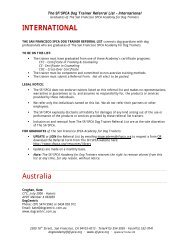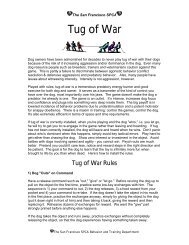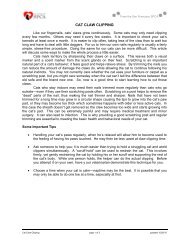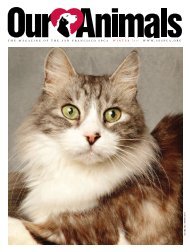Kitten Kindergarten - San Francisco SPCA
Kitten Kindergarten - San Francisco SPCA
Kitten Kindergarten - San Francisco SPCA
Create successful ePaper yourself
Turn your PDF publications into a flip-book with our unique Google optimized e-Paper software.
From the <strong>San</strong> <strong>Francisco</strong> <strong>SPCA</strong> Cat Behavior Program<br />
PETTING-INDUCED AGGRESSION<br />
Most people who have had cats before will tell you that at<br />
some point they have been nipped during petting. Many tend to shrug<br />
it off as “love nips”, or play bites. Other times the nips can be harder,<br />
seeming to come out of the blue and leaving the person wondering why<br />
their cat would react this way during a moment of affection.<br />
This behavior may actually be your cat trying to tell you something about his or her<br />
preferences and tolerance levels. Learning what your cat is trying to communicate may<br />
actually help improve your relationship with your feline companion, and maybe even<br />
decrease your cat’s desire to nip or bite altogether.<br />
Some petting-induced aggression may be related to mating behavior and the<br />
overstimulation that can occur during this interaction. Purring and kneading may lead to the<br />
biting and holding that occurs in pre-copulatory behavior. Other types of petting<br />
aggression may be due to the fact that cats evolved as mostly solitary animals that tend to<br />
have little physical contact with others of their own species, making them more sensitive<br />
to contact. Some cats have experienced inappropriate handling as a kitten and may have<br />
learned to nip or swat to stop the interaction. Petting aggression can also be affected by<br />
physical pain or discomfort if a cat is sick or has arthritis.<br />
The most common scenarios are:<br />
* Your cat is relaxed and happy on your lap, you're watching TV and petting her<br />
absentmindedly...suddenly she turns and bites.<br />
*Your cat starts to swish his tail in response to your petting. You keep petting, and then he<br />
hisses and swats, or gives you a nip and runs off.<br />
*Your cat does not like certain areas of her body touched. The most common "sensitive<br />
spots" are paws, lower back, belly, and chest. If you pet her in those spots, she will bite<br />
you.<br />
* Your cat gets over-excited (also called over-stimulated) while being petted. Usually, the<br />
kitty will start moving faster, head butt your hand, become agitated and busy, and at some<br />
point during the escalating energy, will bite or scratch you.<br />
A majority of cats exhibit over-stimulation or petting aggression to some degree.<br />
However, cats vary enormously as to the extent to which they like petting or handling and<br />
for how long they tolerate these without finding it unpleasant. They also vary greatly in<br />
the number of warning signals and intensity of their resulting aggressive reaction if<br />
warning signals are not seen, or are ignored. Many times, the cat has learned to bite in<br />
Petting-Induced Aggression page 1 of 5 updated 05/22/09<br />
\\Sf1-file-1\common\Adoption\Adoption\Forms and Procedures\Adoption Packet Handouts\Cat Adoption Packet\Petting Induced<br />
Aggression.doc
















